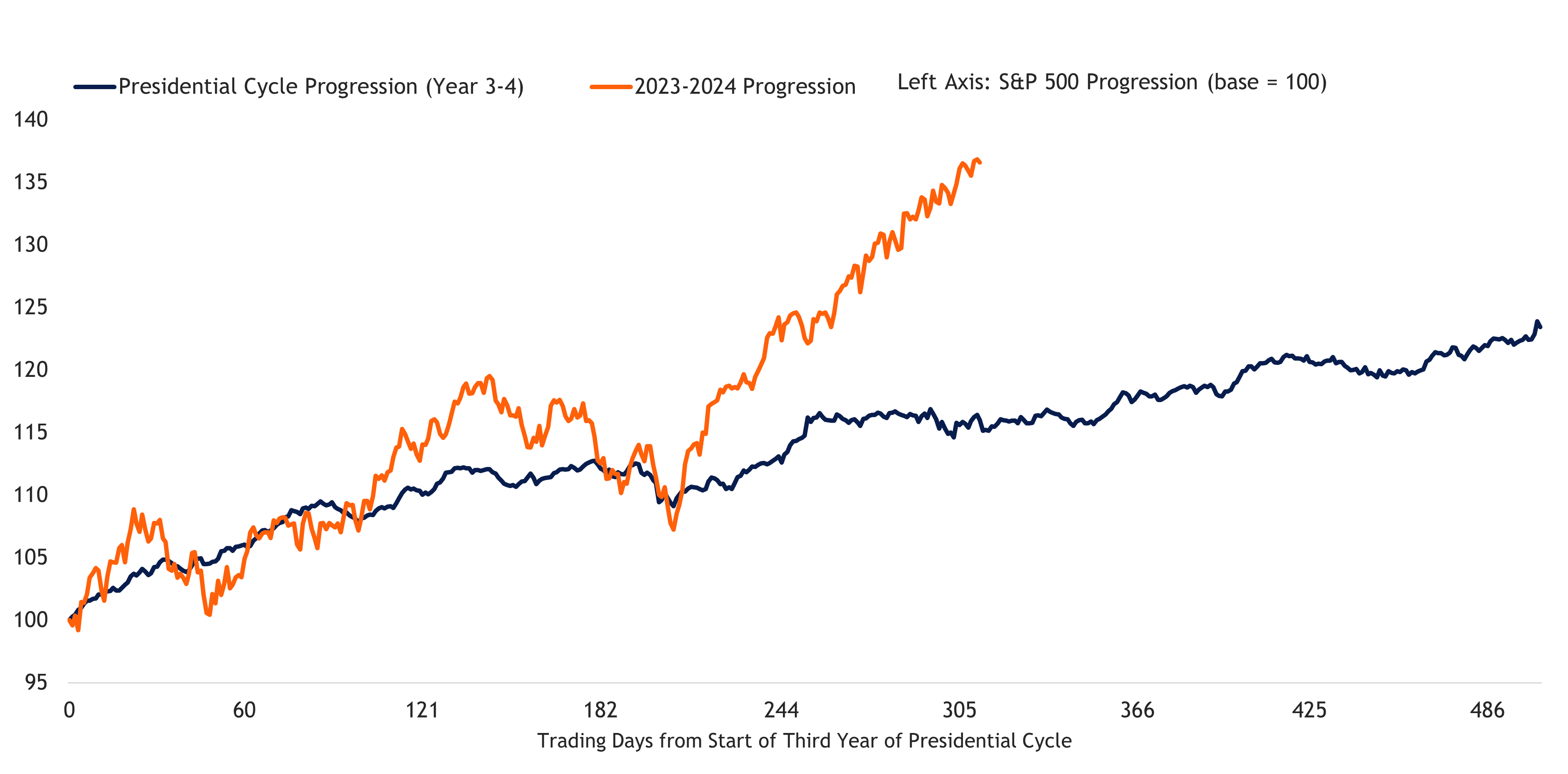Can Pre-Election Market Trends Survive This Attention?
Apr 8, 2024
 Let’s talk seasonality. For those that are unfamiliar, seasonality is the tendency for markets to perform better during some calendar periods and worse during others in a somewhat predictable way. One of the more amazing things about 2023 and part of the first quarter of 2024 is how well U.S. equity markets have been following the historical pre-presidential election seasonal path. The idea of the presidential cycle is predicated on the belief that the executive branch’s economic pursuits, priorities, and the desire to get re-elected are a primary influence on the stock market in the two years before an election. One could even argue that this influence is more relevant today than before, given the heavy fiscal-interventionist approaches that the current and previous administrations have pursued.
Let’s talk seasonality. For those that are unfamiliar, seasonality is the tendency for markets to perform better during some calendar periods and worse during others in a somewhat predictable way. One of the more amazing things about 2023 and part of the first quarter of 2024 is how well U.S. equity markets have been following the historical pre-presidential election seasonal path. The idea of the presidential cycle is predicated on the belief that the executive branch’s economic pursuits, priorities, and the desire to get re-elected are a primary influence on the stock market in the two years before an election. One could even argue that this influence is more relevant today than before, given the heavy fiscal-interventionist approaches that the current and previous administrations have pursued.
As the chart below details (focus less on the amplitudes in price and more on the turning points), the S&P 500 has been following the election calendar seasonality rather well over the last year, as most of the zigs and zags have occurred when the presidential cycle seasonality suggested it would. However, as this pattern has evolved and become more visible, it has become more widely discussed and may add risk over the next few months. Widely watched things in markets have a habit of not working for very long, as too many participants collectively acting on the same thing will inherently disrupt the pattern and can alter the path that the market is headed in. Over the last few weeks, we have seen the S&P 500 more noticeably deviate course. Only time will tell if the current presidential cycle seasonality is ending early, but next month should shed some light on that question. If the S&P 500 is still following the suggested seasonal path, then weakness and a low in May would be expected to be followed by strength in the index over the summer. However, if the current uptrend fails to pause in May or we notice weakness develop and extend well into June, then it will be a strong sign that this round of election year seasonality has indeed subsided early.
S&P 500 Progression During Year Three and Four of Presidential Cycle (1951–YTD)

Source: LPL Research, Bloomberg 04/01/24
Disclosures: All data as of 1951–YTD. Past performance is no guarantee of future results. All indexes are unmanaged and can’t be invested in directly. The modern design of the S&P 500 stock index was first launched in 1957. Performance back to 1950 incorporates the performance of predecessor index, the S&P 90.
For more insights and resources, be sure to sign up for our Weekly Market Commentary. Follow our YouTube channel where we regularly post our Epic Market Minute videos. Follow us on LinkedIn, or like us on Facebook. And as always, please don’t hesitate to reach out to a dedicated service professional at Epic Capital.
IMPORTANT DISCLOSURES
This material is for general information only and is not intended to provide specific advice or recommendations for any individual. There is no assurance that the views or strategies discussed are suitable for all investors. To determine which investment(s) may be appropriate for you, please consult your financial professional prior to investing. Investing involves risks including possible loss of principal. No investment strategy or risk management technique can guarantee return or eliminate risk. Indexes are unmanaged and cannot be invested into directly. Index performance is not indicative of the performance of any investment and does not reflect fees, expenses, or sales charges. All performance referenced is historical and is no guarantee of future results. This material was prepared by LPL Financial, LLC. All information is believed to be from reliable sources; however LPL Financial makes no representation as to its completeness or accuracy. Unless otherwise stated LPL Financial and the third party persons and firms mentioned are not affiliates of each other and make no representation with respect to each other. Any company names noted herein are for educational purposes only and not an indication of trading intent or a solicitation of their products or services. Asset Class Disclosures – International investing involves special risks such as currency fluctuation and political instability and may not be suitable for all investors. These risks are often heightened for investments in emerging markets. Bonds are subject to market and interest rate risk if sold prior to maturity. Municipal bonds are subject and market and interest rate risk and potentially capital gains tax if sold prior to maturity. Interest income may be subject to the alternative minimum tax. Municipal bonds are federally tax-free but other state and local taxes may apply. Preferred stock dividends are paid at the discretion of the issuing company. Preferred stocks are subject to interest rate and credit risk. They may be subject to a call features. Alternative investments may not be suitable for all investors and involve special risks such as leveraging the investment, potential adverse market forces, regulatory changes and potentially illiquidity. The strategies employed in the management of alternative investments may accelerate the velocity of potential losses. Mortgage backed securities are subject to credit, default, prepayment, extension, market and interest rate risk. High yield/junk bonds (grade BB or below) are below investment grade securities, and are subject to higher interest rate, credit, and liquidity risks than those graded BBB and above. They generally should be part of a diversified portfolio for sophisticated investors. Precious metal investing involves greater fluctuation and potential for losses. The fast price swings of commodities will result in significant volatility in an investor's holdings. Securities and advisory services offered through LPL Financial, a registered investment advisor and broker-dealer. Member FINRA/SIPC. Not Insured by FDIC/NCUA or Any Other Government Agency | Not Bank/Credit Union Deposits or Obligations | Not Bank/Credit Union Guaranteed | May Lose Value
More Insights
Few terms in personal finance are as important, or used as frequently, as “risk.” Nevertheless, few terms are as imprecisely defined. Generally, when financial advisors or the media talk about investment risk, their focus is on the historical price volatility of the asset or investment under discussion.
As Americans get their grills and beach chairs ready for the July 4th holiday, the stock market and the weather across much of the country have both been on heaters. Stocks and bonds continue to effectively navigate a complex policy landscape shaped by evolving trade dynamics, geopolitical tensions, and fiscal stimulus. The market’s resilience in … Continue reading “Market Update – America Gets Record High Stock Prices for Its Birthday”
Birthdays may seem less important as you grow older. They may not offer the impact of watershed moments such as getting a driver’s license at 16 and voting at 18. But beginning at age 50, there are several key birthdays that can affect your tax situation, health-care eligibility, and retirement benefits.
During times like these when geopolitical headlines can be unsettling for investors, we at LPL Research like to remind ourselves of one of our key investing principles. Markets have always faced challenges —ranging from geopolitical conflicts and economic downturns to natural disasters, political upheaval and health crises. These events often trigger short-term volatility and shake … Continue reading “Why Long Term Investing Beats Selling in Volatile Times”
Are you concerned about the inheritance taxes your heirs may have to pay? Then you may want to consider creating charitable lead trusts.
Services
Epic Capital provides the following comprehensive financial planning and investment management services: Learn More >


 Top of Page
Top of Page











